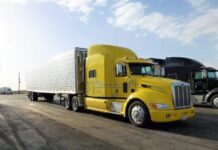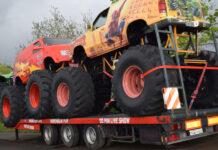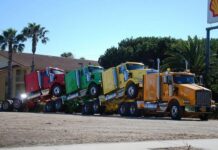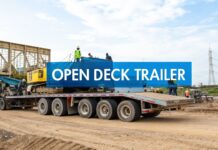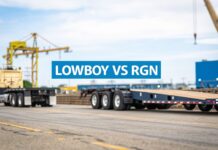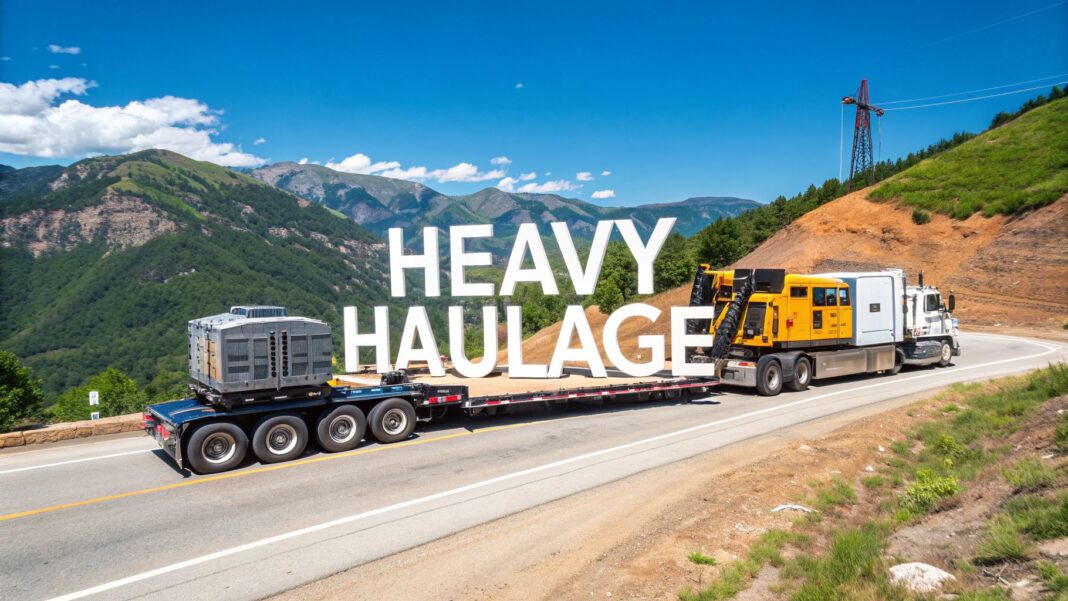
Heavy haulage training is the specialized education required to transport loads that are too heavy or oversized for standard trucks. This discipline is fundamentally different from general freight, demanding expertise in advanced vehicle control, complex load securement, and a deep understanding of transport regulations to ensure every move is safe and compliant. This guide provides actionable insights for breaking into the high-stakes world of moving massive equipment and structures.
Building Your Foundation for Heavy Haulage
Before you can operate a rig hauling a 100-ton generator, you must build a solid professional foundation. This process is about more than passing a test; it involves developing the mindset and core skills that define elite heavy haul operators. The journey starts with a critical first step.
Your first, non-negotiable requirement is a Commercial Driver's License (CDL) Class A. This license is the bedrock of any professional trucking career in the United States, certifying you to operate combination vehicles with a gross weight of 26,001 pounds or more. Without a CDL-A, a career in heavy haulage is impossible.
Mastering the CDL Class A Essentials
Acquiring a Class A license is an intensive process designed to ensure you understand the mechanics and legalities of handling a large commercial vehicle. The process involves passing written exams covering general knowledge, air brakes, and combination vehicles.
These are not simple tests. The air brake exam, for instance, requires detailed knowledge of the entire system, from identifying slack adjusters and brake chambers to executing a proper leak-down test. The combination vehicles test will assess your understanding of critical concepts like coupling procedures and the dangerous "crack-the-whip" effect, which can cause a trailer to overturn.
After the written exams, you must pass a hands-on skills test. This practical exam is where you demonstrate your ability to conduct a thorough pre-trip inspection, execute precise backing maneuvers like straight-line and parallel parking, and safely operate the truck in real-world traffic conditions.
More Than Just a License
While the CDL is your entry ticket, a successful heavy haulage career is built on a reputation for reliability and safety. Your professional profile must meet stringent industry standards:
- A Clean Driving Record: A history of accidents or serious violations will immediately disqualify you from most high-value heavy haulage jobs.
- A Valid DOT Medical Card: You must be medically certified to operate a commercial vehicle through regular physical examinations.
- A Drug-Free Status: Passing pre-employment and random drug screenings is a mandatory federal requirement.
These are not just formalities; they are proof to employers that you are a low-risk, responsible professional who can be trusted with immense responsibility and high-value cargo.
The most overlooked part of heavy haulage training is building soft skills. Unshakeable patience during a complicated loading process, quick problem-solving when a route gets blocked, and incredible spatial awareness—these are the things that truly separate the pros from the average driver.
Developing the Right Operator Mindset
Effective heavy haulage training instills a specific mindset: you learn to anticipate challenges, think five steps ahead, and communicate with absolute clarity to your pilot cars, escort team, and spotters. As you build this foundation, it is beneficial to explore modern training methods; understanding what is interactive video for corporate training provides insight into how technology creates more effective learning for complex roles like this.
This foundational stage is also the perfect time to familiarize yourself with the equipment and terminology of the industry. While you won't be operating them yet, you should know the difference between a lowboy, a flatbed, and a step-deck. Get a head start by researching the 6 major types of hauling equipment to understand the machinery you will soon command. Laying this groundwork now sets you up for success when advanced, hands-on training begins.
Securing Your Essential Licenses and Endorsements
A CDL Class A is the price of admission, but in heavy haulage, specialization is what builds a career. This field demands precision, proven expertise, and the right credentials to handle the most complex and lucrative loads. Each additional endorsement and certification you earn is a tool that proves your capability and value.
To transition from a standard truck driver to a heavy haul specialist, you must acquire specific qualifications. While not every certification is mandatory for every job, the more credentials you hold, the more indispensable you become to an employer.
Key CDL Endorsements to Pursue
Certain endorsements are consistently requested in job postings for oversized transport, signaling to companies that you are a versatile operator ready for complex challenges.
Focus your efforts on these valuable additions to your license:
- Doubles/Triples (T) Endorsement: This is crucial. Many heavy haul operations use multi-axle trailers, jeeps, and dollies to distribute extreme weight. The T endorsement proves you can safely manage these long, articulated vehicle combinations.
- Tank Vehicle (N) Endorsement: While it may seem unrelated, a tanker endorsement is surprisingly useful for hauling large, cylindrical cargo like industrial tanks, silos, or massive pipes. The skills required to manage the high center of gravity and potential for load shifting are very similar to handling liquid surges.
- Hazardous Materials (H) Endorsement: Many large industrial components, such as machinery or transformers, may contain residual chemicals classified as hazardous materials. The H endorsement opens up a significant range of high-value industrial projects that are off-limits to other drivers.
Acquiring these endorsements is a strategic career move. A driver holding T, N, and H endorsements is not just a driver; they are a logistical problem-solver equipped for the most demanding hauls.
The real difference between a good driver and a great heavy haul operator often comes down to certifications. A CDL gets you in the door, but specialized credentials are what get you the keys to the most impressive rigs and the highest-paying jobs.
Specialized Certifications That Employers Are Looking For
Beyond your CDL, specialized certifications are how you truly differentiate yourself. These credentials often involve hands-on training that validates your practical skills for the entire operation, from initial loading to final placement.
The table below provides a quick overview of the most valuable credentials, what they cover, and their impact on your career.
Key Heavy Haulage Credentials Overview
| Credential | Primary Purpose | Typical Requirement | Career Impact |
|---|---|---|---|
| CDL Class A | Foundation for all commercial driving in the U.S. | Written & skills tests, medical exam | The non-negotiable starting point. |
| T Endorsement | Operating vehicles with multiple trailers. | Written knowledge test. | Essential for multi-axle configurations. |
| H Endorsement | Transporting hazardous materials. | Written test, security threat assessment. | Opens doors to higher-paying industrial loads. |
| NCCCO Rigger/Signaler | Safely rigging loads and signaling cranes. | Written & practical exams. | Makes you invaluable on complex job sites. |
| Advanced Securement | Mastering complex load-securing techniques. | Private training course completion. | Demonstrates elite-level safety competence. |
Holding a combination of these credentials signals to an employer that you understand the entire scope of a heavy haul operation.
Industry data highlights a strong focus on comprehensive training. The field is built on skill, and the high 85% pass rate for annual compliance inspections demonstrates that this commitment to professionalism pays off.
To truly stand out, focus on certifications related to pre-transport operations.
Actionable certifications to pursue include:
- Advanced Load Securement: This goes beyond simply adding more chains. Certified training programs delve into the physics of securing immense, often asymmetrically-shaped loads. You will learn to calculate working load limits, understand the importance of chain angles, and use friction to ensure a multi-ton piece of equipment remains completely stable.
- Crane Signaling and Rigging: The heavy haul driver is a key team member during loading and unloading. A certification from an organization like the National Commission for the Certification of Crane Operators (NCCCO) is a significant advantage. Being a certified Rigger Level I or Signalperson enables you to communicate clearly and safely with crane operators—a vital skill when millions of dollars of equipment are in the air.
- Forklift Operation: While it may seem basic, forklift certification is incredibly practical on a job site. It allows you to assist with positioning dunnage, moving equipment, and being a more active and valuable part of the loading team, which companies highly value.
These licenses and certifications are more than just paperwork; they are verifiable proof of your professionalism and commitment to safety. In an industry where a single mistake can be catastrophic, this documented expertise is precisely what top heavy haulage companies seek.
Developing Advanced Hands-On Operator Skills
While certifications get your foot in the door, your heavy haulage career is forged through practical experience on the road and in the yard. This is where theory gives way to the immense responsibility of managing loads of unconventional size and weight. The best heavy haulage training is laser-focused on these practical, real-world skills.
Mastery of this job isn't about rote memorization of rules; it's about developing an instinct for how a massive rig behaves under extreme stress. This is what separates a driver from a true operator who can command a complex, articulated machine carrying an irreplaceable, multi-million-dollar asset.
The Physics of Balancing and Securing Asymmetrical Loads
The first practical lesson in heavy haulage is that no two oversized loads are alike. A 200-foot wind turbine blade possesses extreme length and flexibility, behaving completely differently than a squat, top-heavy industrial boiler.
Effective training moves beyond basic tie-down rules and into applied physics. You will learn to visually identify a load's true center of gravity—which is rarely in the physical center—and position it on the trailer to achieve optimal axle weight distribution. This critical skill is what prevents deadly trailer sway or a catastrophic rollover during a turn.
Actionable skills you will master include:
- Calculating Working Load Limits (WLL): This is not just about using enough chains. It involves selecting the right grade and number of chains and binders to safely handle the immense forces cargo experiences during hard braking or sharp turns.
- Understanding Chain Angles: This is a critical detail. A 45-degree angle provides the optimal combination of downward and sideways force. Angles that are too steep or too shallow render your securement ineffective. Mastering this detail prevents a load from shifting.
- Using Dunnage and Cribbing: You will gain hands-on experience placing wooden blocks (dunnage) to protect cargo and create a stable, level base on the trailer, which is essential for irregularly shaped equipment.
A key component of this skillset is proficiency in rigging and lifting heavy equipment. The driver is often a crucial part of the loading and unloading team, and knowing how to prepare a load before a crane is involved separates professionals from amateurs.
Advanced Driving Techniques for Multi-Axle Trailers
Maneuvering a multi-axle trailer is a completely different discipline than driving a standard semi. The sheer length and weight fundamentally alter how the vehicle responds to every input from the cab.
The most common mistake I see new operators make is underestimating their turning radius. With a 19-axle setup, you might need to start your turn a full city block before the intersection just to keep your trailer from taking out a traffic light.
Advanced training places you in these scenarios within a controlled environment. You will practice executing "button-hook" turns in tight urban settings—swinging wide in the opposite direction before committing to the turn. You will also learn to manage momentum on steep mountain descents, using your engine brake and strategic gear selection to maintain control without overheating your service brakes, which can lead to disaster.
The Art of Route Planning and Pilot Car Coordination
The final piece of the puzzle is executing a live haul. This is where the intricate coordination of route planning, permit compliance, and constant communication with your pilot cars comes together. A real-world haul, such as moving a massive industrial boiler through three states, illustrates this perfectly.
The U.S. heavy haulage sector is a major hub for this type of work, with the market seeing steady growth of about 4.2% annually. The transport costs for these jobs show you just how complex they are, averaging $3 to $8 per mile for domestic moves, and sometimes more depending on the route's challenges.
Here’s a breakdown of the planning and coordination on a real job:
- Route Surveying: Before the haul begins, a detailed survey identifies every potential obstacle: low bridges, weak overpasses, tight roundabouts, and power lines that may require utility crews to lift.
- Permit Compliance: Each state has its own regulations for oversized loads, dictating travel times (often at night), the number of required pilot cars, and other conditions. As the driver, you must be familiar with the permits for every jurisdiction you enter.
- Team Communication: The driver and pilot car operators function as a single unit, connected by constant radio communication. The lead pilot acts as your eyes down the road, calling out hazards and traffic well in advance, allowing you to anticipate rather than just react.
This seamless coordination is the key to a successful heavy haul. It transforms a potential logistical nightmare into a precisely executed operation, proving that in this business, your hands-on skill is your most valuable asset.
Navigating Safety and Regulatory Compliance
In heavy haulage, there is zero room for error. Safety is not a priority; it is the foundation of every action. A single missed detail during an inspection or a shortcut on a permit can lead to catastrophic failure. Therefore, a comprehensive understanding of all applicable regulations is non-negotiable.
This commitment to safety and compliance protects your cargo, the public, and your career. It requires mastering a complex web of federal laws, state-specific permits, and hands-on equipment checks that must become second nature.
The stakes continue to rise. The global heavy lifting and haulage market reached an estimated USD 264.15 billion in 2024, driven by large-scale construction and energy projects. This growth creates a high demand for professionals who can transport massive loads while expertly navigating a maze of regulations.
Demystifying Federal Regulations
The Federal Motor Carrier Safety Administration (FMCSA) sets the baseline regulations for all commercial trucking. These rules carry extra weight in heavy haulage due to the elevated risks. Any quality heavy haulage training program will ensure you have a thorough, working knowledge of these regulations.
A primary focus is Hours-of-Service (HOS). The FMCSA is extremely strict about managing driver fatigue. For oversized loads, these rules are often even more restrictive, as many permits limit travel to specific hours—frequently overnight—to minimize traffic disruption. You must become a master of your logbook to maintain compliance while maximizing your available driving time.
The real challenge isn't just knowing the federal rules. It's understanding how they clash and combine with dozens of different state laws. A haul that's perfectly legal in Texas can suddenly be a violation the moment you cross the line into Louisiana.
The Patchwork of State-Level Permitting
This is where regulatory compliance becomes truly complex. Each state's Department of Transportation has a unique set of rules for oversized loads. A haul crossing three states requires three separate permits, and each will have different requirements.
Your training must prepare you for this logistical puzzle. Key differences include:
- Dimensional Limits: The definition of "oversized" varies. One state may set the width limit at 8.5 feet, while its neighbor allows up to 9 feet.
- Pilot Car Requirements: A 12-foot-wide load might require one pilot car in one state, while the next state demands a lead car, a chase car, and a police escort for the exact same load.
- Travel Restrictions: Most states prohibit oversized travel on holiday weekends, and many enforce specific curfews that can halt your progress.
A single error on a permit application can bring a multi-million-dollar project to a complete stop.
The Critical Role of Pre-Trip Inspections
Your pre-trip inspection is your final defense against mechanical failure on the highway. For a specialized heavy haul rig, this is an exhaustive, systematic process that requires a trained eye and unwavering discipline.
Your inspection checklist must be meticulous, covering every critical component of your specialized trailer.
- Hydraulic Systems: Visually inspect every line for leaks or damage, especially on systems that operate a gooseneck or steering axles.
- Axle and Suspension Components: Check for cracked welds, worn bushings, or any signs of metal fatigue on multi-axle setups.
- Tires and Brakes: With extreme weight, proper tire pressure is critical. Every brake on every axle must be visually inspected to ensure it is correctly adjusted.
- Securement Gear: Manually inspect every chain, binder, and strap for nicks, cracks, or stretching. A single faulty binder can compromise the entire load.
Beyond daily checks, a solid understanding of essential vehicle maintenance procedures is what keeps a fleet safe and compliant. This proactive approach involves identifying and addressing small problems before they become catastrophic failures on the road.
Embracing New Industry Technology and Trends
The heavy transport industry is evolving rapidly, driven by technology. Staying current with the latest innovations is no longer optional—it is essential for career longevity. Understanding the tools inside a modern rig ensures you are prepared not just for today's job, but for the future of the industry.
Paper maps and logbooks are relics of the past. Today's heavy haul operator is supported by a suite of digital tools that provide crucial data and streamline complex operations. Proficiency with this technology is a core component of modern heavy haulage training.
The Power of Telematics and Digital Logging
Advanced telematics systems are at the heart of modern fleets. These are more than simple GPS trackers; they provide a live feed of data on everything from engine performance and fuel consumption to driving behaviors like hard braking. For the company, this data is invaluable for scheduling maintenance and improving fleet safety.
For the operator, the most significant piece of this technology is the Electronic Logging Device (ELD). While ELDs are a federal mandate for tracking Hours-of-Service (HOS), their practical advantage is simplifying compliance. They log driving time automatically, eliminating manual errors and making roadside inspections fast and efficient.
Sophisticated Software for Precision Route Planning
Planning a route for a heavy haul is a high-stakes puzzle where one wrong turn can result in a stuck rig, damaged infrastructure, or a massive fine. Specialized routing software is an indispensable tool for mitigating these risks.
This is not a standard GPS application. These programs are designed specifically for oversized loads, allowing dispatchers to map routes that account for every potential obstacle.
- Bridge Weight Limits: The software cross-references your rig's gross weight with a database of federal and state bridge ratings to prevent you from using unsafe crossings.
- Vertical Clearances: It flags low overpasses, power lines, and tunnels, ensuring your load has a clear path from start to finish.
- Road Restrictions: The system remains current with construction zones, seasonal road closures, and routes where oversized vehicles are prohibited.
The biggest shift in the last decade isn't the size of the loads, but the intelligence we use to move them. The technology in the cab today gives an operator more real-time information and predictive insight than an entire dispatch team had twenty years ago.
The Future of Heavy Haul Trucks
The industry is also preparing for major shifts in vehicle technology, particularly with alternative fuels. While diesel remains dominant, change is underway. The heavy haul truck market, valued at USD 34.5 billion in 2023, is growing due to these technological advancements. In 2024, the first Class 8 electric semi completed a cross-border haul, demonstrating that the future is closer than many think. You can explore the market trends shaping heavy haulage training to see how the landscape is evolving.
This evolution means future training will need to cover new ground. Operators will require training on the unique characteristics of electric or hydrogen trucks, such as their instant torque, regenerative braking, and the new logistical challenges of planning routes around charging infrastructure.
The bottom line is that technological proficiency is no longer optional. A willingness to learn and adapt to new systems is what will distinguish the best operators, making you a valuable asset to any forward-thinking company.
Your Questions About Heavy Haulage Careers, Answered
Considering a career in heavy haulage is a major decision, and it is wise to have questions about the training, the daily reality of the job, and future prospects. Getting clear, factual answers is the first step toward determining if this is the right path for you.
Here are answers to the most common questions from individuals looking to enter this specialized field of transport.
How Long Does It Take to Become a Heavy Haul Operator?
There is no single timeline, as it depends on your starting point. If you are new to trucking, the first step is obtaining your CDL Class A license, which most reputable programs offer in three to seven weeks.
After earning your CDL, the specialized heavy haul training begins. This is not learned quickly. Some companies use an apprenticeship model, where you will spend months with an experienced operator learning the job firsthand. Alternatively, dedicated private training schools offer intensive courses that typically run from four to eight weeks.
What’s the Toughest Part of the Job?
Ask any veteran operator, and they will tell you the most difficult part is not the driving—it is the immense amount of planning required before the truck moves. Driving is a technical skill, but managing the logistics of a massive transport is a masterclass in strategy and foresight.
The true challenges are found in the details:
- Walking the Route: This involves physically driving the entire planned route in a smaller vehicle to verify clearances and identify potential hazards like low-hanging wires, weak road shoulders, or tight corners that digital maps miss.
- The Permit Maze: You must secure the correct permits for every state on your route. Each state has its own rules, and they rarely align perfectly.
- Coordinating the Convoy: As the driver, you are the quarterback, directing pilot cars, utility crews lifting power lines, and sometimes local police escorts. It is a team operation with you at the center.
Successfully maneuvering a 150-foot rig through a small-town roundabout at 2 AM is a true test of a heavy haul professional's skill.
The most challenging days are rarely on the open highway. They're spent on a quiet two-lane road in the middle of nowhere, working with a team to figure out how to safely get a 100-ton load around an obstacle that wasn't on any map. That's where you earn your paycheck.
What Kind of Salary Can I Expect?
Due to the exceptional skill, risk, and responsibility involved, heavy haul operators are among the highest-paid drivers in the transportation industry. Compensation directly reflects the expertise required to move multi-million-dollar assets on public roads.
While salaries vary by location and the type of loads transported, here is a general breakdown of earning potential:
- Newcomers to the heavy haul niche typically start in the $55,000 to $70,000 range.
- Experienced Operators with a solid safety record and several years of experience often earn between $80,000 and $100,000 annually.
- Top-Tier Specialists, who handle massive "superloads" or run their own operations, can easily exceed six figures.
Is There a Strong Demand for Heavy Haul Drivers?
Absolutely. The demand for qualified heavy haul drivers is consistently strong. Our economy depends on the transport of large items: infrastructure components, wind turbines, factory machinery, and power plant transformers all require movement by skilled professionals.
This sector of the industry is not subject to wild fluctuations. In fact, the general truck driver shortage is felt even more acutely here because very few drivers possess the advanced skills and clean record necessary. For dedicated professionals, this translates into excellent job security and significant opportunities for career advancement.
When you're ready to move oversized loads, you need a partner with proven expertise. We Will Transport It offers reliable, secure, and professional heavy equipment transport services nationwide. Learn more about our heavy haul solutions and get your free quote today.


